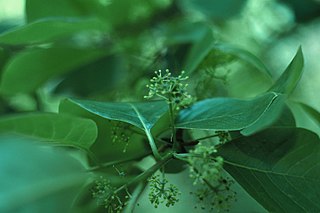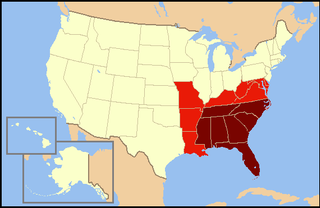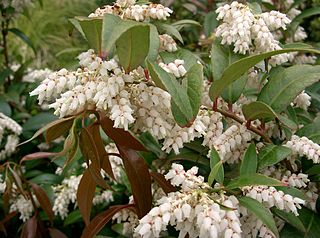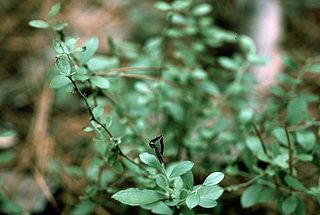Related Research Articles

Spanish moss is an epiphytic flowering plant that often grows upon larger trees in tropical and subtropical climates, native to much of Mexico, Bermuda, the Bahamas, Central America, South America, the Southern United States, West Indies and is also naturalized in Queensland (Australia). It is known as "grandpas beard" in French Polynesia. In the United States from where it is most known, it is commonly found on the southern live oak and bald-cypress in the lowlands, swamps, and marshes of the mid-atlantic and southeastern United States from central Delaware to southeastern Virginia to Florida and west to Texas and southern Arkansas.

Tupelo, genus Nyssa, is a small genus of deciduous trees with alternate, simple leaves. It is sometimes included in the subfamily Nyssoideae of the dogwood family, Cornaceae, but is placed by other authorities in the family Nyssaceae. In the APG IV system, it is placed in Nyssaceae.

Rosa laevigata, the Cherokee rose, is a white, fragrant rose native to southern China and Taiwan south to Laos and Vietnam, and invasive in the United States.

Southern Europe is the southern region of the European continent. Most definitions of Southern Europe, also known as Mediterranean Europe, include Italy, Malta, Greece, Croatia, Bosnia and Herzegovina, Montenegro, Albania, Slovenia, Spain, Southern France, East Thrace or European Turkey and Cyprus. Also often included despite not having a coast in the Mediterranean are Portugal, Serbia, North Macedonia, Andorra, San Marino and Vatican City.

The Northern United States, commonly referred to as the American North, the Northern States, or simply the North, is a geographical or historical region of the United States.

The Southeastern United States, also referred to as the American Southeast or simply the Southeast, is, broadly, the eastern portion of the Southern United States and the southern portion of the Eastern United States. It comprises at least a core of states on the lower East Coast of the United States and eastern Gulf Coast. Expansively, it includes everything south of the Mason–Dixon line, the Ohio River and the 36°30' parallel, and as far west as Arkansas and Louisiana. There is no official U.S. government definition of the region, though various agencies and departments use different definitions.

Helianthus is a genus of plants comprising about 70 species. Except for three species in South America, all Helianthus species are native to North America and Central America. The common names "sunflower" and "common sunflower" typically refer to the popular annual species Helianthus annuus, whose round flower heads in combination with the ligules look like the sun. This and other species, notably Jerusalem artichoke, are cultivated in temperate regions and some tropical regions as food crops for humans, cattle, and poultry, and as ornamental plants. The species H. annuus typically grows during the summer and into early fall, with the peak growth season being mid-summer.

Leucothoe is a genus of about 50 species of flowering plants in the family Ericaceae, native to Asia, the Americas and Madagascar.

Sabal minor, commonly known as the dwarf palmetto, is a small species of palm. It is native to the deep southeastern and south-central United States and northeastern Mexico. It is naturally found in a diversity of habitats, including maritime forests, swamps, floodplains, and occasionally on drier sites. It is often found growing in calcareous marl soil. Sabal minor is one of the most frost and cold tolerant among North American palms.

Vaccinium erythrocarpum – also commonly known as mountain blueberry, southern mountain cranberry, bearberry, arando, and dingleberry – is a species of cranberry.

Liatris is a genus of flowering plants in the boneset tribe within the sunflower family native to North America. Its most common name is blazing star. Some species are used as ornamental plants, sometimes in flower bouquets.
The Botanical Research Institute of Texas (BRIT) is a global botanical research institute and learning center located in the Cultural District of Fort Worth, Texas. BRIT moved to its new 70,000-square-foot (6,500 m2) facility adjacent to the Fort Worth Botanic Garden from their original downtown location in spring 2011.

Vaccinium tenellum, the small black blueberry is a plant species native to the southeastern United States from southeastern Mississippi to northern Florida to southern Virginia. It grows in forests and in shrubby areas at elevations up to 200 m.
Alan Stuart Weakley is an American botanist with expertise in the systematics, ecology, and conservation of the flora of the Southeastern United States. Weakley is the director of the UNC Herbarium at the North Carolina Botanical Garden and an adjunct associate professor at the University of North Carolina at Chapel Hill. He is the author of Flora of the Southern & Mid-Atlantic States, a manual covering the approximately 7000 vascular plants found in the Southeastern United States.

Hypericum tenuifolium, known as Atlantic St. John's-wort and sandhill St. John's-wort, is a species of flowering plant in the St. John's wort family, Hypericaceae. It is native to the Southeastern United States.

Hypericum suffruticosum, known as pineland St. John's-wort, is a species of flowering plant in the St. John's wort family, Hypericaceae. It is native to the Southeastern United States.

Hypericum frondosum, the cedarglade St. Johnswort or golden St. John's wort, is a species of flowering plant in the St. Johnswort family, Hypericaceae. It is native to the central and southeastern United States in dry, rocky habitats.

Hypericum fasciculatum, known as peelbark St. Johnswort or sandweed, is a species of flowering plant in the St. Johnswort family, Hypericaceae, native to the southeastern United States. It is found from eastern North Carolina, south to southern Florida, west to eastern Louisiana. Kew's Plants of the World Online database also notes that it occurs in Cuba, though Cuba is not listed in several other sources. It was first described in 1797 by Jean-Baptiste Lamarck.

Hypericum lobocarpum, commonly called fivelobe St. Johnswort, is a species of flowering plant in the St. Johnswort family (Hypericaceae). It is native eastern to North America, where it is found primarily in the western portion of the southeastern United States. Its typical natural habitat is in open wet areas, such as stream banks, lake margins, swamps, and pine savannas.
References
- ↑ Makers of American Botany, Harry Baker Humphrey, Ronald Press Company, Library of Congress Card Number 61-18435